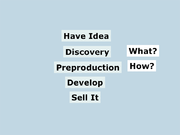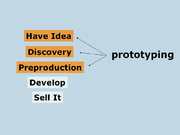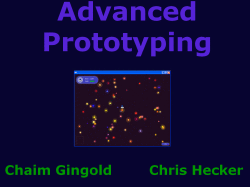m |
m |
||
| Line 19: | Line 19: | ||
* We changed two of the intro slides to reflect the current thinking on the production process, where prepro is split out into ''discovery'' and ''preproduction'', and we talked about how prototyping is most useful during the first three stages:<br>[[Image:Gdc2006-AdvancedPrototyping1.png|180px]] [[Image:Gdc2006-AdvancedPrototyping2.png|180px]] | * We changed two of the intro slides to reflect the current thinking on the production process, where prepro is split out into ''discovery'' and ''preproduction'', and we talked about how prototyping is most useful during the first three stages:<br>[[Image:Gdc2006-AdvancedPrototyping1.png|180px]] [[Image:Gdc2006-AdvancedPrototyping2.png|180px]] | ||
* We mentioned one new additional metric at end, which is how often is your prototype referred back to in the archive? If nobody ever looks at it again, then either it was answering a really simple question | * We mentioned one new additional metric at end, which is how often is your prototype referred back to in the archive? If nobody ever looks at it again, then either it was answering a really simple question and completely answered the question, full stop, or it maybe wasn't as useful at answering questions as you originally thought since nobody felt the need to use it to clarify or remind people of the solution. | ||
There was some press and blog coverage of the talk: | There was some press and blog coverage of the talk: | ||
Revision as of 20:06, 28 May 2007
Chaim Gingold and I gave a fun lecture at the 2006 Game Developers Conference titled, Advanced Prototyping. Here's the abstract:
Creating effective prototypes of game designs, user interfaces, and technologies requires a unique set of skills and knowledge, somewhat distinct from the skills used in making a game. This lecture discusses creating these various types of prototypes from an advanced and in-depth perspective. The talk goes through a number of important questions and topics that should be addressed before, during, and after the prototype is created, including metrics for judging the effectiveness of prototypes, how to decide the focus of a prototype, how to design, start, and build the prototype, both from a content and a code standpoint, and how to iterate the prototype via testing and integrating feedback. Various approaches to these issues are compared and contrasted, with the end goal of teaching attendees how to create successful and high quality prototypes.
It's in the new fangled presentation style all the kids are doing these days, which means it's basically useless without hearing the audio, so:
We gave the talk again at the 2006 Montreal International Game Summit, and then once again at Ubisoft after that conference.
The GDC version went off really well—I was incredibly happy with it. The MIGS version was fine, but we felt it was a bit low energy in comparison, and we were kind of bummed that we ended on a relative low note. But then, immediately afterwards, friends at Ubisoft Montreal invited us to give it again at their office, and that version turned out to be the best of the three. I think we spent 1.5+ hours and made the presentation totally interactive.
We changed a few minor things for the later presentations. The two worth mentioning are:
- We changed two of the intro slides to reflect the current thinking on the production process, where prepro is split out into discovery and preproduction, and we talked about how prototyping is most useful during the first three stages:


- We mentioned one new additional metric at end, which is how often is your prototype referred back to in the archive? If nobody ever looks at it again, then either it was answering a really simple question and completely answered the question, full stop, or it maybe wasn't as useful at answering questions as you originally thought since nobody felt the need to use it to clarify or remind people of the solution.
There was some press and blog coverage of the talk:
One of the meta-goals of this talk was to learn what makes a good two-person talk. You can see the lessons we learned here.




